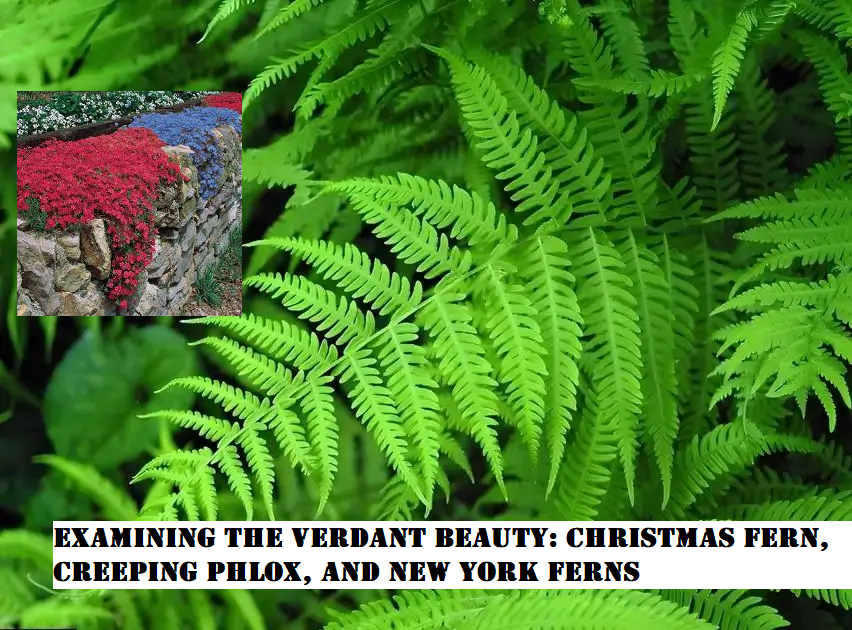
Amidst the complex web of natural marvels, some plants are particularly notable for their lushness and timeless allure. The New York fern, creeping phlox, and Christmas fern are a few examples of these botanical wonders, each with a special charm and ecological value. Come along as we explore the fascinating world of these well-loved plants, learning about their traits, helpful hints for growing them, and the priceless contributions they provide to natural environments and garden settings.
New York Ferns in Woodland Gardens: An Elegant Tapestry
Thelypteris noveboracensis, sometimes known as the New York fern, grows as a tapestry of elegance in the shadowed nooks and crannies of eastern woodlands. Its delicate texture and finely split fronds beautify forest floors. This deciduous fern, which is native to North America, grows best in chilly, damp soils with some shade. It creates dense colonies of lush greens that provide as a home and shelter for a variety of woodland animals.
The ability of the New York fern to thrive in a variety of environments, such as moist wooded soils, rocky slopes, and stream banks, is one of its distinguishing characteristics. Because of its resilience, it’s a great option for stabilising slopes, bringing texture to shady borders, and naturalising woodland areas. It is also a great asset in gardens where deer are possible because of its resistance to deer browsing.
It’s not too difficult to cultivate New York ferns; all you need is well-drained soil and frequent irrigation to keep the soil moist. Periodic pruning eliminates damaged or dead fronds and encourages healthy development, while mulching the area at the base of the plants helps them retain moisture and discourages weed growth. New York ferns flourish in woodland gardens when given the right care, captivating onlookers with their classic beauty and subtle elegance.
Springtime Splendour: Cascades of Colour with Creeping Phlox
Phlox subulata, often known as creeping phlox, is a brilliant harbinger of spring that covers rocky slopes, garden borders, and rock gardens with cascades of colourful blossoms as spring awakens the landscape. This evergreen perennial is native to North America and is highly valued for its tendency to form mats and abundance of star-shaped flowers that come in pink, purple, blue, and white hues.
The capacity of creeping phlox to flow from containers, fall over walls, and drape gently over garden boundaries is one of its most striking features. This effect creates a beautiful display of texture and colour. Because of its slow growth rate, it is a great ground cover for sunny slopes and rock gardens, where it improves the aesthetics of the area while providing stability and erosion control.
For best growth and flowering, creeping phlox needs well-drained soil, full sun to partial shade, and minimal irrigation. This is a fairly easy cultivation. While mulching the area surrounding the base of the plants helps conserve soil moisture and discourages weed growth, regular watering during the establishment phase aids in the promotion of root development. Deadheading wasted blooms on a regular basis promotes reblooming and keeps the plant looking neat.
With its brilliant blooms and spreading habit, creeping phlox offers a touch of springtime splendour to garden landscapes. Its kaleidoscope of colours and textures draws pollinators and admirers alike.
Evergreen Beauty for Shaded Gardens: Christmas fern
The evergreen beauty and durability of Polystichum acrostichoides, sometimes known as the Christmas fern, are emblematic of the dappled shade found in forests and forest borders. This native fern, so named because of its propensity to stay green all winter, brings year-round interest to shady gardens, where its glossy fronds and graceful form lend a feeling of peace and tranquilly.
The ability of Christmas fern to thrive in a variety of environments, from damp, well-drained soils to dry shade, is one of their unique qualities. Because of their versatility, they grow well with other plants like hostas, astilbes, and heucheras in native plantings, woodland gardens, and shady borders.
Christmas fern are generally low-maintenance to cultivate; they need well-drained soil and full to partial shade to thrive. While mulching the area surrounding the base of the plants helps conserve soil moisture and discourages weed growth, regular watering during the establishment phase aids in the promotion of root development. Regular trimming guarantees that the ferns stay neat and appealing all year long by getting rid of damaged or dead fronds and encouraging healthy growth.
Christmas fern give shady settings a touch of timeless beauty with their evergreen leaf and graceful manner. They also serve as a useful backdrop for other woodland plants and year-round interest.
The Importance of the Environment and Wildlife Habitat
In addition to being aesthetically pleasing, Christmas fern, creeping phlox, and New York ferns are essential for maintaining regional ecosystems and wildlife habitats. Being natural plants, they offer important food and cover to a range of forest animals, such as insects, birds, and small mammals. The dense foliage of New York ferns provides habitat for insects and bird nesting sites, and the nectar-rich blooms of creeping phlox draw pollinators like butterflies and bees, which in turn help pollinate neighbouring plants. In a similar vein, Christmas fern boost the biodiversity and ecological resilience of natural habitats and garden landscapes by offering year-round shelter and foraging opportunities for wildlife. Gardeners may create healthy, biodiverse landscapes that benefit people and wildlife alike by cultivating these native plants.
Finishing: Preserving the Beauty and Diversity of Nature
To sum up, New York ferns, Christmas fern, and creeping phlox are magnificent specimens of nature’s richness and beauty that enhance landscapes with their grandeur and support the health and vitality of nearby ecosystems. People may make beautiful and biodiverse environments while also improving the environment by adopting these cherished plants and using them in their gardens and natural settings. Whether they cascade over rocky slopes in vibrant flowers, embellish woodland gardens with graceful fronds, or provide year-round appeal in shady landscapes, these plants never cease to astound and inspire reverence, serving as a constant reminder of the eternal power and majesty of the natural world.
These plants are vital to the health of the surrounding environment in addition to adding aesthetic value to their surroundings. They are important resources for both ecological sustainability and human enjoyment since their presence maintains the environment’s general health and balance.

